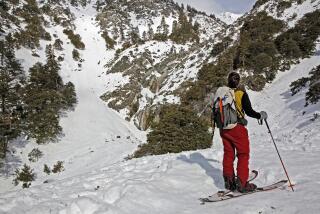Claws of life
Before Eugene Kumm vanished Jan. 18 on Mt. San Gorgonio, a forest official warned him about the treacherous ice on rugged Vivian Creek Trail and the need to carry a crucial piece of gear: crampons, metal spikes that hikers attach to their boots to provide traction in perilous winter conditions.
The 25-year-old Seal Beach man assured the official that he had crampons in his backpack along with a sleeping bag, tent and heavy clothes for an overnight stay along the trail about a thousand feet below the 11,502-foot summit.
“From our conversation, he seemed prepared,” said Pam Bierce, assistant supervisor of visitor information for the U.S. Forest Service’s Mill Creek Station, who also issued Kumm a permit on Jan. 3 for the same trail. The search for Kumm, who was last spotted above his camping site, was suspended Sunday until next weekend.
Since the first of the year, local mountains have claimed five lives. A half-dozen rescues have been made, and mountain 911s have become unnervingly numerous in San Bernardino County.
“A number of these deaths have had isolated falls involved,” said Ruth Wenstrom, a U.S. Forest Service spokeswoman. “Last year in the same area, we never had crampon conditions.”
The common cause may be extremely icy conditions, which prompted officials to issue an unusual one-page warning that urged hikers not to go solo and to use heavy-duty crampons that bite into snow and ice, a mountaineer’s ice ax and a helmet.
Warnings about conditions have been posted since early this year, but three days after Kumm disappeared, hikers were given fliers along with permits for high-altitude trails near San Gorgonio.
Ten-point crampons, which alpinists in Europe began using in the early 1900s, evolved into 12-point models, used mainly by ice climbers to improve toe grip.
“Crampons don’t save your life — they’ll help you save your life,” said Rick Agnelli, a climber and climbing gear salesman at REI in Northridge. For steep slopes such as Mt. Baldy or Mt. San Gorgonio, these models offer maximum traction on snow and ice when going uphill and downhill, Agnelli said. A pair of 10-plus-point crampons can run $100 to $150.
Less expensive models, known as instep crampons, cost about $35 to $40. They affix to the arch of the boot but usually have only four spikes. They are adequate on flat surfaces, Agnelli said, but “if you go up or down icy terrain in those, you’re courting disaster.”
The same goes for ice grippers, which slip onto the bottom of shoes or boots and provide lightweight traction but have no spikes.
Before attempting a steep climb for the first time, hikers also need to learn to use the gear properly. Walking with crampons requires a wider stance and stride to avoid gashing legs or feet as you hurry along the trail. The learned stance also helps prevent hikers from tripping because it can keep crampons from catching on their pant legs.
“If you’re sliding and you stick your feet out with these points strapped to them, the steel or aluminum alloy points will grab the snow,” Agnelli said. “You can snap ankles quickly. It’s the most common ice-climbing injury.”
But in current alpine hiking conditions on Southern California’s snowy peaks, crampons alone won’t save you. “If you’re wearing crampons, you should be using an ice ax,” said Erik Siering, a Sierra Club leader and mountaineer. “There’s a tendency to feel secure using crampons with ski poles, and that’s ridiculous. If you slip, you’d better have an ice ax.”
An ice ax has a head with a pick on one side and an adz on the other, and a long shaft with a spike at the bottom to penetrate ice and snow. It’s used to stop or self-arrest if you hurtle down a slope. The tool, which most people would recognize in films or photographs in the hands of climbers hauling themselves up Everest, will save you only if you have it in your hands at all times and know how to use it.
“It’s something you have to practice, not something you can read in a book or learn on the fly,” Agnelli said. There are several ways to self-arrest, which involves using your body weight to anchor the ice ax while in motion.
Trekking poles, which are ubiquitous on trails in just about every season, may provide stability on icy trails but aren’t sturdy enough to save you from falling to an icy death.
A hard-shell helmet, also known as an alpine climber’s helmet, won’t protect you from broken bones if you fall — but it could save your life. Foam-based bicycle helmets won’t work, Agnelli said, because they are likely to shatter at the point of impact. Helmets also protect hikers and climbers from falling objects.
“Someone could drop a water bottle that weighs two pounds,” Agnelli said. “I’ve seen one fall and break an arm.”
Outdoors Institute columnist Julie Sheer has the week off. To read previous Outdoors Institute columns, go to latimes.com/juliesheer.
More to Read
Start your day right
Sign up for Essential California for news, features and recommendations from the L.A. Times and beyond in your inbox six days a week.
You may occasionally receive promotional content from the Los Angeles Times.







